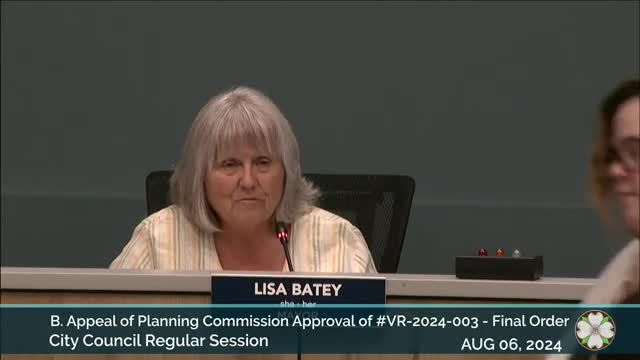Council debates contentious home expansion amid community concerns
August 06, 2024 | Milwaukie, Clackamas County, Oregon
This article was created by AI summarizing key points discussed. AI makes mistakes, so for full details and context, please refer to the video of the full meeting. Please report any errors so we can fix them. Report an error »

In a recent city council meeting, discussions centered around a proposed home expansion that has sparked community interest and concern. The applicant defended their proposal, emphasizing that it adheres to existing construction criteria and aims to minimize impacts on neighboring properties. The addition is planned to be built solely on the applicant's concrete driveway, ensuring it does not extend beyond the current footprint of the house.
Council members engaged in a thorough debate regarding the implications of the proposed variance, particularly focusing on the existing six-inch setback from property lines. Some councilors expressed support for the application, arguing that it represents a minimal impact on the surrounding environment and aligns with the need for increased housing space. They highlighted the importance of considering the current built environment and the historical context of the property, which was established long before modern setback regulations were in place.
Conversely, other council members raised concerns about the potential negative impacts on neighboring properties, arguing that extending the existing structure could exacerbate issues related to privacy and aesthetics. They emphasized the need to uphold zoning regulations designed to prevent overcrowding and maintain community standards.
The council ultimately decided to uphold the planning commission's approval of the application, with a vote reflecting a majority in favor. This decision underscores the ongoing challenge of balancing individual property rights with community interests in urban planning. The council's deliberations highlighted the complexities of land use decisions, particularly in established neighborhoods where historical context and modern needs often collide.
Council members engaged in a thorough debate regarding the implications of the proposed variance, particularly focusing on the existing six-inch setback from property lines. Some councilors expressed support for the application, arguing that it represents a minimal impact on the surrounding environment and aligns with the need for increased housing space. They highlighted the importance of considering the current built environment and the historical context of the property, which was established long before modern setback regulations were in place.
Conversely, other council members raised concerns about the potential negative impacts on neighboring properties, arguing that extending the existing structure could exacerbate issues related to privacy and aesthetics. They emphasized the need to uphold zoning regulations designed to prevent overcrowding and maintain community standards.
The council ultimately decided to uphold the planning commission's approval of the application, with a vote reflecting a majority in favor. This decision underscores the ongoing challenge of balancing individual property rights with community interests in urban planning. The council's deliberations highlighted the complexities of land use decisions, particularly in established neighborhoods where historical context and modern needs often collide.
View full meeting
This article is based on a recent meeting—watch the full video and explore the complete transcript for deeper insights into the discussion.
View full meeting
